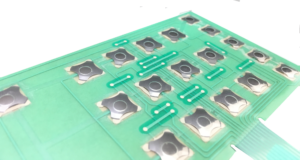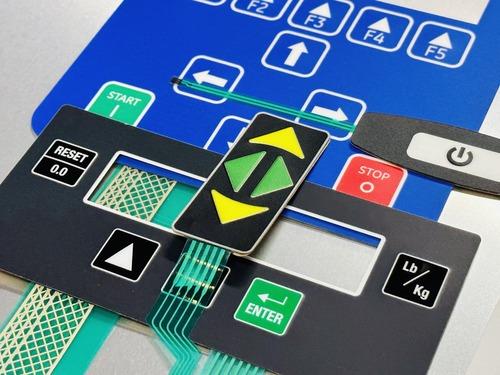Discover Exactly How Membrane Switches Function and Their Duty in Modern Electronics
Membrane Switches represent an innovative combination of innovation and layout within the realm of modern-day electronic devices, working as essential interfaces in numerous gadgets. Consisted of several layers, these buttons make use of pressure-sensitive systems to help with user interaction. Their applications cover different sectors, from consumer electronics to clinical tools, highlighting their versatility and value. Recognizing the ins and outs of Membrane button performance and their more comprehensive implications in boosting individual experience welcomes additional exploration into their design, benefits, and the ingenious developments shaping their future in technology.
What Are Membrane Buttons?

Membrane buttons are distinguished by their toughness and resistance to environmental variables, such as dust, dampness, and severe temperature levels. They can be personalized with numerous graphics, colors, and responsive responses alternatives, enhancing user experience while maintaining visual charm - membrane switches. Moreover, the consolidation of printed circuits permits smooth assimilation into devices, boosting overall performance.
The flexibility of Membrane switches is obvious in their ability to sustain both complicated and basic control functions. They can incorporate attributes such as LED indications and touch-sensitive technology, accommodating certain customer requirements. As technology remains to progress, Membrane Switches remain vital for making it possible for efficient and user-friendly individual interfaces, thereby playing a critical function in the advancement of modern electronic gadgets.
Parts of Membrane Buttons
Membrane buttons are composed of several key components that interact to create a reputable and practical user interface. The primary elements include the visuals overlay, glue layer, spacer layer, and conductive traces.
The graphic overlay acts as the user interface, typically published on an adaptable substratum such as polyester or polycarbonate. This layer not just supplies aesthetic appeal but likewise consists of responsive feedback, visual cues, and safety features. Beneath the graphic overlay lies the adhesive layer, which safeguards the button to the gadget and makes certain longevity against environmental stresses.
The spacer layer is important for keeping the required space in between the visuals overlay and the circuit layer. This gap permits the activation of the button when stress is used. The conductive traces, usually made from silver or carbon, develop the electric paths that finish the circuit when the button is involved.
Additionally, a backing layer may be consisted of for architectural assistance and insulation. These parts collaborate perfectly, making sure that Membrane buttons are both resilient and user-friendly, making them important in numerous modern-day digital applications.
Exactly How Membrane Switches Work
How do Membrane Switches function successfully within electronic gadgets? Membrane Switches operate the concepts of pressure-sensitive innovation, utilizing a split building and construction that consists of graphic overlays, adhesive layers, and conductive components. When a customer uses pressure to the switch, the top layer warps, enabling the conductive elements underneath to make contact and finish an electric circuit. This activity triggers the preferred function within the device.
The layout of Membrane buttons is crucial for their reliable operation (membrane switches). The layers are diligently crafted to provide responsive feedback, toughness, and resistance to ecological factors such as moisture and dirt. The inclusion of domes-- little, increased areas within the switch-- boosts responsive feedback, providing customers with an obvious click sensation upon activation
Moreover, Membrane switches can site link be tailored in terms of dimension, form, and graphics, making them appropriate for numerous applications. They are often utilized in control panels, medical devices, and consumer electronics because of their streamlined style and dependability. On the whole, the reliable performance of Membrane switches is pivotal in boosting individual interaction and ensuring smooth operation in modern-day digital tools.

Applications in Modern Tools
Using their one-of-a-kind layout and performance, Membrane switches have actually become indispensable elements in a vast array of contemporary electronic gadgets. These functional interfaces are used in customer electronic devices, industrial devices, medical gadgets, and automotive controls, giving smooth customer communication.
In consumer electronics, Membrane switches are frequently found in appliances like microwaves, washing devices, and various other family tools, where they enable user-friendly control with a smooth account. Their inconspicuous design helps with combination right into portable tools, improving aesthetic charm without endangering performance.
In commercial applications, Membrane Switches act as control panels for machinery, using toughness and resistance to extreme environments. Their capability to stand up to wetness and pollutants makes them discover this info here optimal for use in manufacturing and handling markets.
Clinical gadgets additionally benefit from Membrane buttons, which are designed to be easy to tidy and keep, guaranteeing hygiene in professional setups. They are commonly used in diagnostic tools, individual monitoring systems, and mobile clinical devices, where integrity is vital.
Advantages of Membrane Switches
One of the key advantages of Membrane buttons is their versatility, which permits them to be tailored for a range of applications across numerous sectors. These switches can be made in different forms and sizes, fitting distinct item requirements while supplying smooth assimilation into tools. Their thin account makes it possible for a smooth and compact style, often enhancing the visual appeal of digital browse around this site items.
Another significant benefit is their resilience - membrane switches. Membrane buttons are generally resistant to dust, moisture, and chemicals, making them optimal for extreme environments. This durability expands their lifespan compared to typical mechanical switches, lowering the need for constant replacements
Furthermore, Membrane Switches offer cost-effectiveness. The production procedure involves printing innovations that reduce manufacturing prices, particularly for big runs. This cost, incorporated with low maintenance requirements, makes them an appealing choice for makers.

Conclusion
Finally, Membrane Switches stand for a considerable innovation in interface technology within contemporary electronics. Their layered building, pressure-sensitive operation, and versatility to different applications emphasize their significance throughout numerous sectors. The sturdiness and ecological resistance of Membrane Switches additionally improve their appeal, making them a preferred option for makers looking for customizable and reliable options. As the need for resistant and user-friendly interfaces remains to grow, the role of Membrane buttons in shaping customer experience will definitely broaden.
Membrane Switches represent an innovative combination of modern technology and design within the world of contemporary electronics, offering as vital interfaces in many devices.In the realm of modern-day electronics, Membrane Switches offer as essential elements that promote user interaction with gadgets. As modern technology continues to advance, Membrane Switches continue to be crucial for making it possible for intuitive and effective customer interfaces, thereby playing an essential duty in the advancement of modern digital gadgets.
How do Membrane Switches feature efficiently within digital tools? Generally, the effective functioning of Membrane buttons is essential in improving individual communication and guaranteeing seamless operation in modern electronic gadgets.